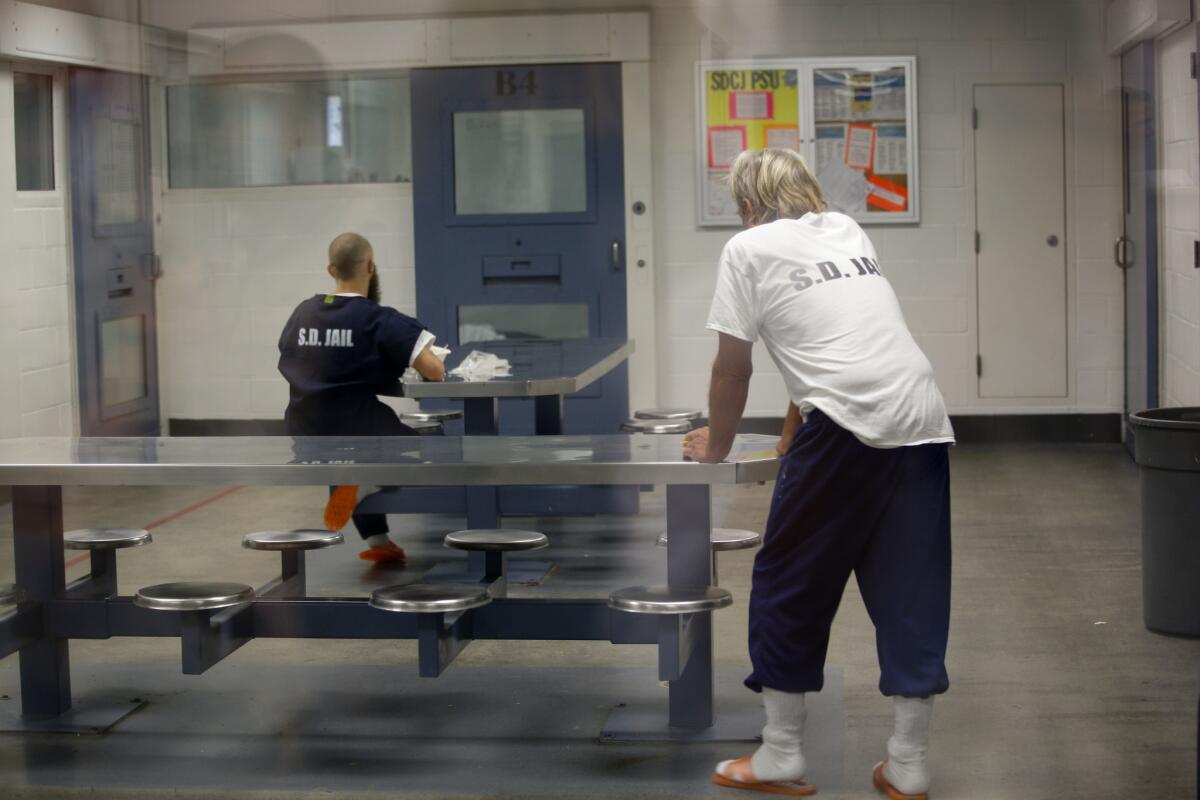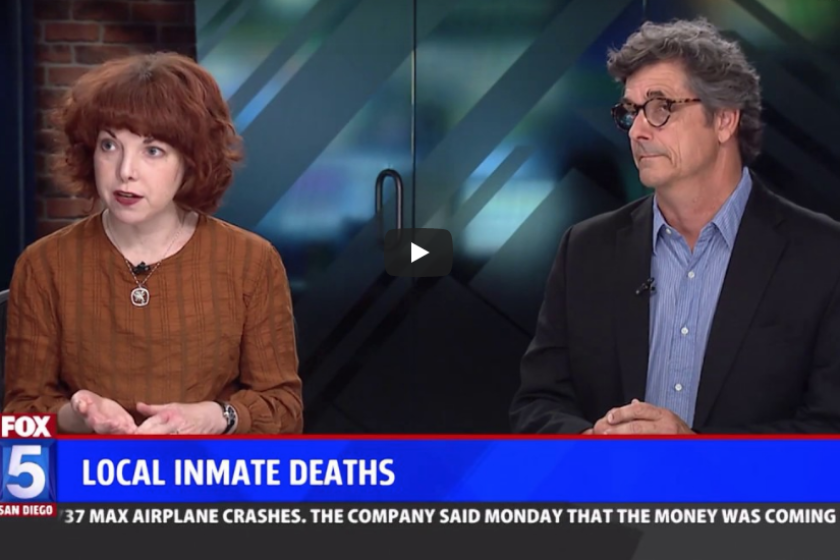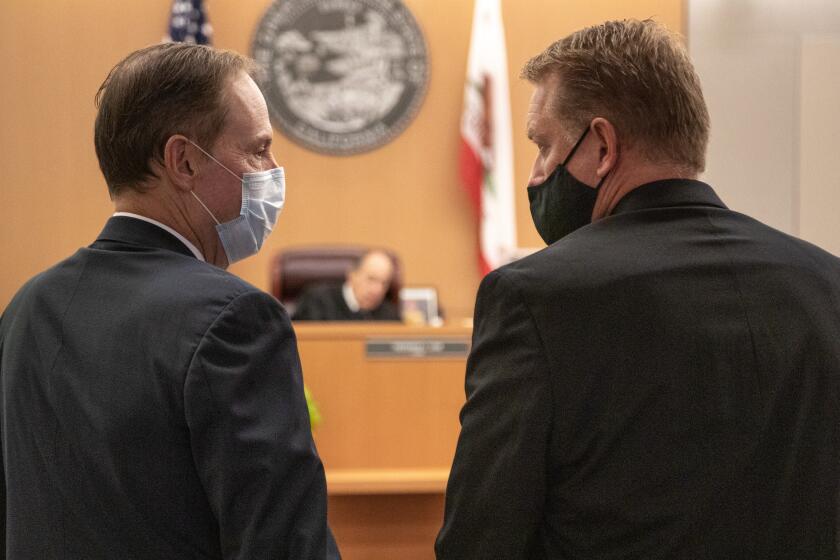Review of San Diego County jail deaths, intended for improvement, criticized as shallow

Study requested by county supervisors will be fourth in three years on jail and cost up to $150,000
San Diego County expects to spend up to $150,000 on a new study of its jail system, the latest effort to defeat a mortality rate that has exceeded most major California county jail systems for years.
The county issued a document last week seeking a “jail facilities review best practices consultant” to produce a report showing how other jails keep mortality rates notably lower than San Diego County’s jails.
It will be at least the fourth independent review of San Diego County jails in three years, not including annual surveys performed by the grand jury. Sheriff Bill Gore has been reluctant to adopt some recommendations by outside researchers.
The latest study will compare detention practices in local jails across California and the United States. In a joint statement, county Supervisors Diane Jacob and Nathan Fletcher expressed confidence the next study will be worthwhile.
“When the review is complete, we will take a hard look at the findings and work with the sheriff on possible next steps,” they wrote. “We called for a review of best practices because we should always strive for ways to improve core county services, and our expectation is that the final product will help meet this goal.”
Some experts say the new examination seems unlikely to delve deep or result in significant improvements, at least if the initial paperwork is an indication.
The Sheriff’s Department declined to discuss the pending examination of jail operations, saying the county’s Public Safety Group is taking the lead on the initiative.
The Public Safety Group administers the law enforcement arms of San Diego County government, including the Sheriff’s Department, District Attorney’s Office and the Probation Department, among others.
The publicly issued request, asking vendors to outline their qualifications to write the report, was issued Monday in response to a six-month investigation published by The San Diego Union-Tribune in September.
The “Dying Behind Bars” series disclosed that at least 140 inmates have died in San Diego County jails since 2009, the year Gore was first appointed sheriff. That number was up from the decade between 1999 and 2008, when 101 people died in custody.
The San Diego County death rate over the past 10 years was 50 percent higher than Los Angeles County’s and two-and-a-half times the Orange County rate, state Department of Justice data show. Santa Clara, Sacramento and San Bernardino counties also had lower jail death rates.
The three-day series of articles, videos and an interactive timeline also showed that lawsuits over lapses in medical and mental health treatment provided by the Sheriff’s Department are costing taxpayers millions of dollars.
San Diego County paid $7.9 million in legal claims related to jail deaths and serious injuries since 2009 — four times the $1.9 million paid over the prior 10 years — and not including a $12.6 million jury award against the county in August.
Sheriff Gore declined multiple requests to discuss inmate deaths in his jails.
His staff issued statements throughout the six-month investigation saying that, when measured in other ways, the San Diego mortality rate was on par with other California counties and that the department is continuously working to improve the medical and mental health treatment provided to inmates.
On the final day of the September series, the Union-Tribune asked all five members of the county Board of Supervisors to comment on how they planned to address the high mortality rate and escalating litigation costs.
Two supervisors — Greg Cox and Kristin Gaspar — did not respond to the request.
Supervisor Jim Desmond issued a statement calling the reports “troubling and disturbing.” Supervisors Dianne Jacob and Nathan Fletcher requested the best practices study now put to competitive bid.
“Any death under these circumstances is tragic, and we will be working with the sheriff to determine what more we can do to reduce these incidents,” the two officials said in a September statement.
Previous studies
The Sheriff’s Department has said it is working to earn accreditation by the National Commission on Correctional Health Care, a national nonprofit organization committed to improving detainee medical and mental health treatment.
The “gold standard” of jail operations is not easily attained.
After a 2017 inspection at four of the seven San Diego County jails, commission researchers filed a 139-page report detailing changes the Sheriff’s Department would need to implement to win accreditation.
“There are still many NCCHC standards to be met,” Asst. Sheriff Frank Clamser wrote in a statement in August. “Some will be completed in the near future and some will require more time due to the complexity and the changes necessary or the resources needed to implement.”
Last year, the advocacy group Disability Rights California, which has federal authority to inspect jails and prisons, issued a separate report detailing lapses in mental health treatment and suicide-prevention efforts in the San Diego County jail system. It said San Diego County over-incarcerates people who are mentally ill and the Sheriff’s Department is deficient in preventing suicides, fails to provide proper mental health treatment and lacks meaningful oversight.
“The inmate suicide rate has been many times higher than similarly sized county jails in California, the state prison system and jails nationally,” Disability Rights California researchers said.
The group recommended annual suicide-prevention training for jail staff, which Gore resisted for months before agreeing to extend the training late last year.
Disability Rights California also said jail officials should examine every suicide attempt to help prevent future deaths. Gore initially rejected the idea. This year, just before “Dying Behind Bars” was published, the department said it would initiate such reviews.
The sheriff’s larger response to the Disability Rights California report was to hire consultant Lindsay Hayes to review practices in San Diego County jails. Hayes, who previously had criticized the county for falling short of best practices, issued a friendlier report that said the department “had the foundation of a good suicide prevention program.”
Hayes criticized Gore and his staff for housing suicidal inmates in conditions he described as “punitive.”
“In many ways, the conditions for suicidal inmates placed in safety cells and (enhanced observation) cells … were harsher than for those on segregation status,” he wrote. “Confining a suicidal inmate to their cell 24 hours a day only enhances isolation and is anti-therapeutic.”
The Sheriff’s Department paid $100,000 for the National Correctional Commission on Health Care report and $25,000 for the Hayes analysis.
‘1-alarm response’
Other detentions experts who reviewed San Diego County’s request for qualifications last week said the “best practices” report stands to be limited in scope.
Ross Mirkarimi is a former San Francisco sheriff and member of that county Board of Supervisors who now works as a jail consultant. He said the San Diego supervisors do not appear to be responding to the number of inmate deaths as seriously as they should be.
“You can’t help wondering why they are holding back on insisting for more urgent reform,” he said. “The tone and tenor of the RFQ is almost analogous to answering a 4-alarm fire with a 1-alarm response.”
Local leaders should act more boldly and forget calling for another study, Mirkarimi said.
“Every county suffers from a pile of studies that reaches to the sky but rarely delivers the intended results,” he said. “We already know the punchline. We’re going to learn that the Sheriff’s Department is under-funded and under-staffed for implementing fundamental reforms.
“Purse-strings aside, what’s truly needed is the political will,” the former sheriff said.
Michele Deitch, an attorney and expert in correctional oversight who teaches at the University of Texas at Austin, said San Diego County leaders already have been told how they could improve treatment and reduce jail deaths.
“They’ve got what they need about best practices. Why are they seeking someone else?” she asked. “How is this adding to what they’ve already got? … For a county that’s been under this level of scrutiny and had that much information for a long time from experts, I don’t get it.”
Deitch said the jails would improve with stricter — and more routine — oversight.
“San Diego doesn’t have any kind of independent oversight of its jails,” the Texas law professor said. “The kinds of stuff that they are looking for are the kinds of things a well-designed oversight body can be doing.”
The Citizens Law Enforcement Review Board, a volunteer panel that reviews jail deaths and complaints against sheriff’s deputies and probation officers, is planning to add jail inspections to its listed duties.
Early plans call for visits to be scheduled in advance and for inspectors to be guided by a jail official. The inspections also would be tied to complaints received by the board.
Deitch said effective oversight requires unannounced visits, and that inspectors should be given “golden key access” to the facilities.
“This is what those folks do — that is their job, going into the facilities on a regular basis,” she said. “They’re there so regularly that the inmates know those are the people they can talk to …. They’re going to be identifying issues and areas for improvement and they’re going to be bringing that outside set of eyes to what’s going on inside.”
No visit required
Whoever wins the contract will not be required to tour any jails or interview any inmates, according to the county’s bid solicitation.
Rather, the consultant “will conduct a literature and report review of national best practices” and be given “access to previously published reports that are relevant to this review,” the request for quotation states.
Under the bid terms, the chosen researcher also cannot have initiated any jail-related lawsuits against a government agency or jurisdiction within the past five years.
Amy Fettig, deputy director of the the National Prison Project for the American Civil Liberties Union, said the consultant who wins the contract should visit the county jails, talk to staff and inmates and examine practices. Researchers also need to review incident reports and talk to people about deaths that already occurred.
“In order to do this right, you’d need both a corrections expert and a medical expert,” she said. “It’s doubtful that people are dying because of written policy — it’s the practice that matters.”
None of the five county supervisors would comment on what might distinguish the new review from the earlier studies performed in 2017 and 2018. Nor did they respond to criticism about its limited scope.
“I welcome any review of the tragic issue of deaths in our county jails, and I will work with the sheriff to seriously consider implementing any proposed recommendations,” Cox said in a statement.
“My colleagues, Chairwoman Jacob and Supervisor Fletcher, have taken a lead on this through their statement Oct. 1,” Desmond wrote in a statement. “I defer to them for comment.”
Gaspar did not respond to the Union-Tribune.
The county provided four weeks for bidders to review the request and submit an offer. The study is expected to be completed by March 15.
Get Essential San Diego, weekday mornings
Get top headlines from the Union-Tribune in your inbox weekday mornings, including top news, local, sports, business, entertainment and opinion.
You may occasionally receive promotional content from the San Diego Union-Tribune.



















